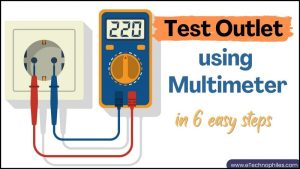Last updated on April 3rd, 2024 at 04:37 pm
You may want to test an outlet for many reasons: to check the AC mains voltage, to find a fault, to identify live and neutral wires, etc. The simplest way to test an outlet is by using a digital multimeter. Since most multimeters can handle AC mains voltage up to 600 volts(maximum outlet voltage is around 220 volts), it is the most reliable and safest equipment for this.
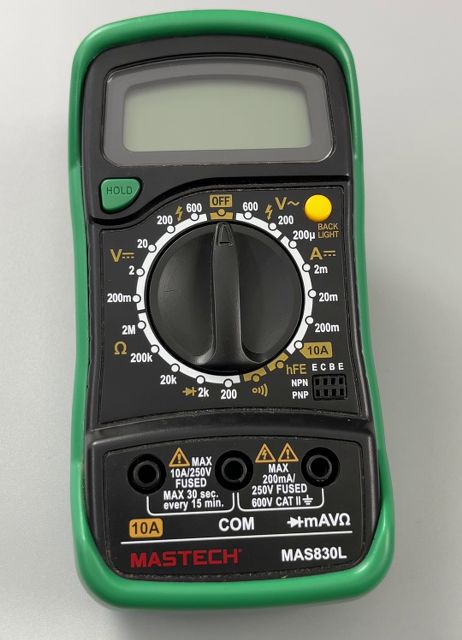
To test 110V outlet using a multimeter, follow these steps:
- Insert the probes into the multimeter’s sockets.
- Select the appropriate AC voltage range.
- Switch off the outlet button and wear safety gear.
- Insert the probes into the outlet(Black first)
- Note down the voltage readings.
- Take out the probes(Red first) and Switch off the button.
Step 1: Insert the probes into the appropriate sockets
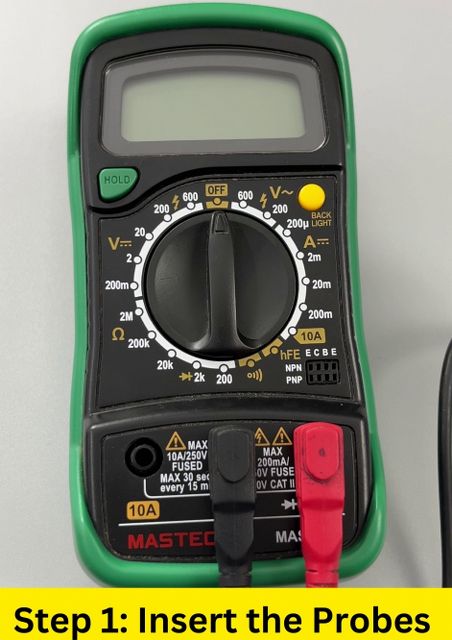
A multimeter usually has three sockets/ports: COM(common or ground), mAVΩ(voltage or resistance), and 10A(current).
Insert the red probe into the mAVΩ socket and the black probe into the COM port, as shown below.
The red probe is inserted into the 10A port when the measured current value exceeds 250mA. This value may vary depending on the multimeter.
Switch on your multimeter if it has an “ON” button. In most of the multimeters, selecting any multimeter symbol other than the “OFF” symbol turns it on.
Step 2: Select the AC voltage function using the rotary dial
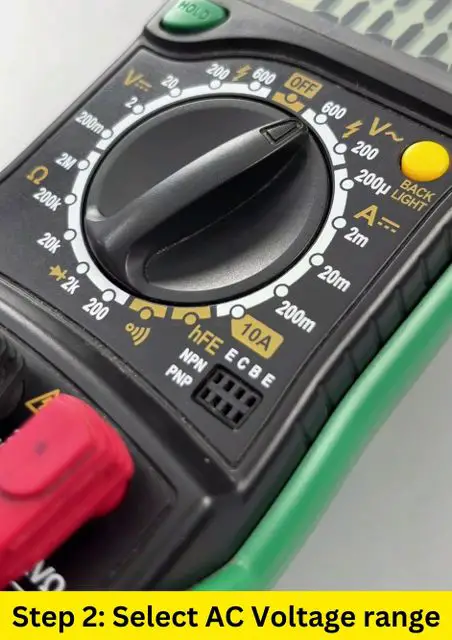
Because you are testing the AC mains voltage from the outlet, select the AC voltage function having a “V~” symbol.
But to select the appropriate range(my multimeter has two: 200 and 600), you must know your country’s domestic electric outlet supply voltage. It will either be 110V or 220V. (Read more)
| Location | Voltage | Frequency |
|---|---|---|
| USA | 110 V | 60 Hz |
| Asia | 220 V | 50 Hz |
| Europe | 220 V | 50 Hz |
| Australia | 220 V | 50 Hz |
| Canada | 120 V | 60 Hz |
I am from Asia, so I have selected the 600 V range. If your outlet voltage is 110 V, then select the 200 V range. These voltage ranges may be different in your multimeter, so select accordingly. As a general rule of thumb, always select the first higher voltage range than your outlet voltage.
Step 3: Switch off the outlet button and wear safety gear
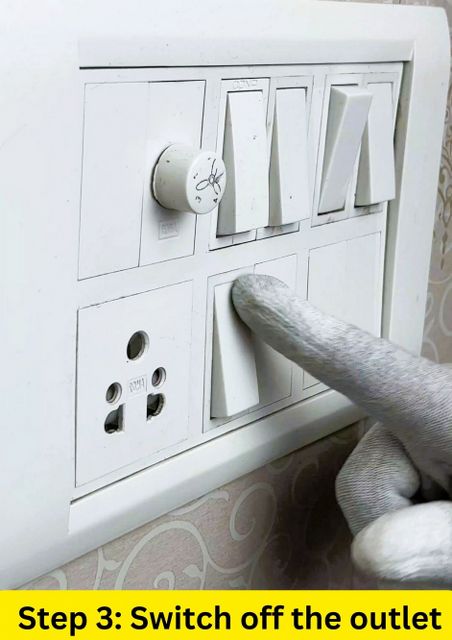
Before testing the outlet, make sure the button is switched off. You may also switch off the corresponding circuit breaker for extra safety.
Ac is dangerous. So always wear gloves, safety glasses, and shoes for proper insulation when performing such tests.
Step 4: Insert the probes into the outlet
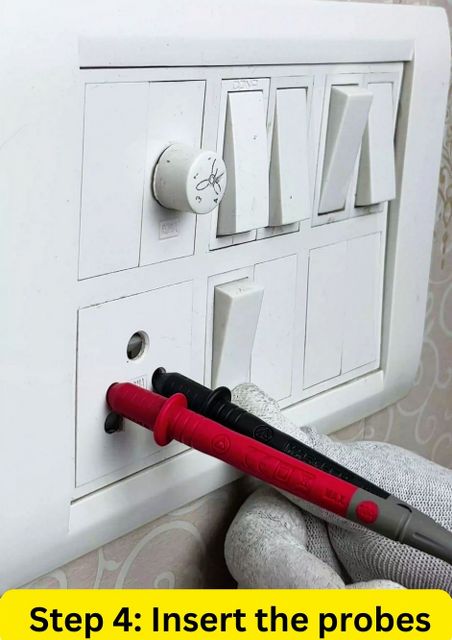
Every outlet or socket has three wires: live, neutral, and earthing. The top hole(bigger one) is for earthing only. Whereas live and neutral may be connected to either of the two remaining holes. The AC voltage is measured between live and neutral; the earthing one is just for safety. So leave it alone.
To test the outlet, hold the multimeter in one hand and insert the probes with the other hand into the outlet. Hold both meter probes with one hand to prevent electric shock from passing through your body if a fault occurs.
Insert the black probe first(left hole) and then the red probe(right hole). Normally, the black probe or COM should be connected to the neutral wire(for extra safety), but there is no way to know firsthand which hole is which. So you can insert the probes in any manner.
Step 5: Note down the reading
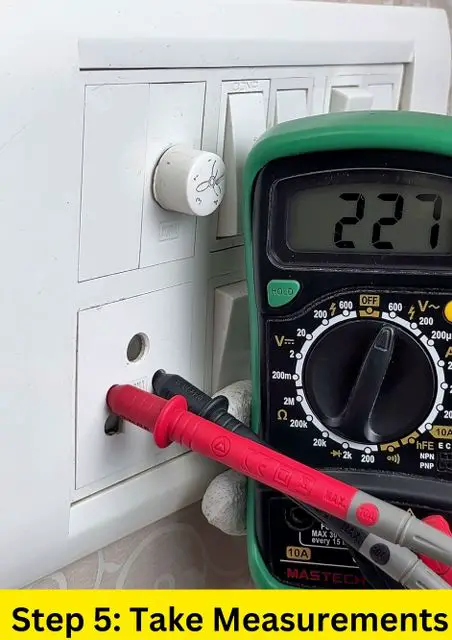
Turn on the outlet switch and wait for the readings to stabilize on the multimeter’s display.
Note down the displayed outlet voltage. You can also use the hold button to freeze the readings on the display.
If the multimeter shows a different voltage every time you turn on the switch, note the readings. These may help you to diagnose the issue later on.
Step 6: Take out the probes and turn off the switch
Once you are happy with the readings, turn off the switch and remove the probes from the outlet.
Remove the red probe first and then the black probe. Turn off the multimeter after use.
How to analyze the outlet voltage readings?
If the outlet voltage displayed by the multimeter is close to your country’s standard domestic supply voltage, then there is no need to worry. For example, the outlet voltage can be anywhere between 220 and 230 volts in Europe and Asia. In USA and Canada, this voltage is around 110 to 120 volts.
If the displayed voltage is not as expected, test the other outlets as well. This can help you answer the questions such as:
- Is every outlet behaving the same way?
- Is the voltage of only one outlet not correct?
- Are outlets in a particular room faulty?
If there is a huge deviation from the standard AC mains voltage, then you should call an electrician.
FAQs
How do you test which outlet wire is live or neutral?
To test which one of the two outlet holes is live, follow these steps:
1. Insert the multimeter probes into the outlet in any manner(except the top hole).
2. If the reading is close to the standard AC supply voltage, continue with the steps given below.
3. Now connect the multimeter between one of these holes and the earth hole.
4. If the voltage between one of the holes and the earth is also close to the standard supply voltage, the hole has a live wire.
5. The hole has a neutral wire if the voltage is around 1V to 5V(ideally 0 V).
How do you test an outlet to see if it’s bad?
Follow the procedure given above for testing the outlet. In case of a huge deviation from the standard AC mains voltage, there is some fault in the outlet.
What setting on the multimeter is for the outlet?
The AC voltage function or settings with a “V~” symbol next to it is for the outlet.
